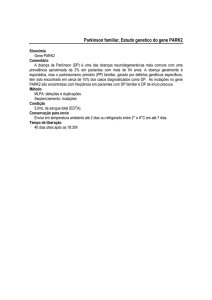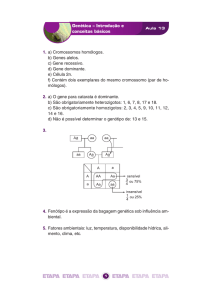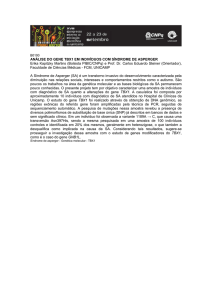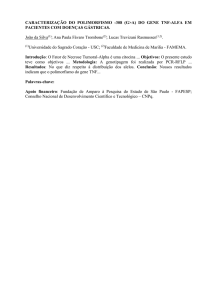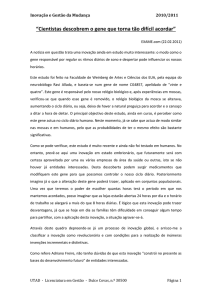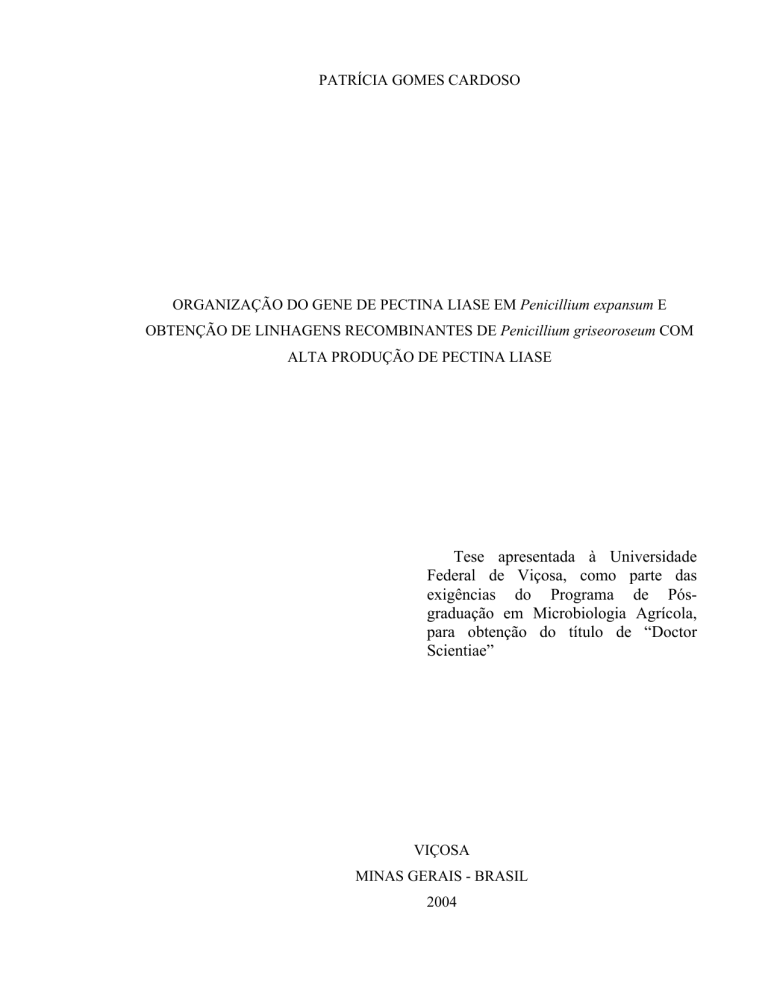
PATRÍCIA GOMES CARDOSO
ORGANIZAÇÃO DO GENE DE PECTINA LIASE EM Penicillium expansum E
OBTENÇÃO DE LINHAGENS RECOMBINANTES DE Penicillium griseoroseum COM
ALTA PRODUÇÃO DE PECTINA LIASE
Tese apresentada à Universidade
Federal de Viçosa, como parte das
exigências do Programa de Pósgraduação em Microbiologia Agrícola,
para obtenção do título de “Doctor
Scientiae”
VIÇOSA
MINAS GERAIS - BRASIL
2004
RESUMO
CARDOSO, Patrícia Gomes, D.S., Universidade Federal de Viçosa, março de 2004.
Organização do gene de pectina liase em Penicillium expansum e obtenção de
linhagens recombinantes de Penicillium griseoroseum com alta produção de
pectina liase. Orientadora: Elza Fernandes de Araújo. Conselheiras: Marisa Vieira de
Queiroz, Virginia Maria Chaves Alves e Flávia Maria Lopes Passos.
A seqüência de nucleotídeos contendo o gene ple1 que codifica pectina liase em
Penicillium expansum foi clonada. Esta seqüência contém 874 nucleotídeos da região
promotora, 1342 nucleotídeos da região codificadora e 469 nucleotídeos da região
terminadora. A região codificadora do gene ple1 é interrompida por dois íntrons, de 101 e
116 nucleotídeos, confirmados pela seqüência do cDNA. Na seqüência da região promotora
de ple1 foi observado cis-elementos envolvidos na regulação da expressão desse gene,
como TATA box (TATATAA) na posição -91 do códon de início da tradução, sendo esta
seqüência precedida por uma região rica em pirimidinas e CAAT box (CCAATT) a -568 do
códon de inicio da tradução. A proteína PLE1, deduzida a partir da seqüência de
nucleotídeos possui 374 resíduos de aminoácidos, com massa molecular estimada de 40,1
KDa e pI calculado de 9,46. Análise por hibridização do DNA total de P. expansum e P.
griseoroseum com um fragmento de DNA de 2,1 Kb que corresponde ao gene pelA de A.
niger, indicou organização semelhante dos genes de PL no genoma destes fungos. A
expressão do gene ple1, avaliada pela hibridização do RNA total com um fragmento de
DNA que corresponde à região estrutural do gene ple1 mostrou que o transcrito foi
detectado durante todo tempo de cultivo em presença de pectina. No entanto, quando
cultivado em presença de sacarose, o transcrito somente foi detectado em 12 e 24 horas de
cultivo, com adição de extrato de levedura. A caracterização morfológica de P. expansum e
P. griseoroseum mostrou diferenças nítidas tanto no diâmetro quanto na coloração do verso
viii
das colônias destes fungos. Diferenças na organização da região subtelomérica dos
cromossomos de P. expansum e P. griseoroseum, foram observadas quando o plasmídeo
pTEL13 foi utilizado como sonda. A região ITS do rDNA de P. expansum tem 600 pb e de
P. griseoroseum 594 pb. As linhagens transformantes obtidas com os plasmídeos pPlg1 e
pNPG1, apresentaram aumentos na atividade de PL de no máximo 3 vezes. Análise por
hibridização do DNA total dos transformantes indicou a ocorrência de integrações
homólogas e heterólogas de pelo menos duas cópias do gene plg1. Foi construído um vetor
de expressão, denominado pAN52-Plg1 que continha o gene plg1 sob o controle do
promotor forte constitutivo do gene (gpdA) de A. nidulans. A transformação da linhagem
mutante PG63 utilizando este vetor e o pNPG1, resultou na obtenção de uma linhagem
recombinante (105) com aumento de 58 vezes na atividade de PL, quando cultivada em
presença de glicose como fonte de carbono. Seis linhagens recombinantes foram avaliadas
por hibridização apresentando integração heteróloga de mais de uma cópia do gene plg1 no
genoma. Avaliação das proteínas extracelulares por eletroforese (SDS-PAGE) mostrou a
presença de uma banda nítida e forte de aproximadamente 40 KDa presente no
sobrenadante de cultivo da linhagem recombinante 105 que corresponde a PLG1. A
atividade específica aparente de PL sintetizada por esta linhagem foi 44 e 27 vezes maior
do que aquela obtida para linhagem mutante PG63 e de uma preparação comercial de
pectinases “Citrus Clear”, respectivamente. O cultivo da linhagem recombinante 105 em
meio contendo caldo de cana promoveu uma atividade de PL 132 vezes maior do que a
atividade obtida pela linhagem PG63 cultivada nesta mesma fonte de carbono. A atividade
de PL da linhagem recombinante 105, cultivada em diferentes volumes de meio, aumentou
linearmente com o tempo. Pectina cítrica, quando utilizada como substrato, promoveu
maior atividade de PL. A enzima mostrou ser estável em ampla faixa de pH e temperatura
de armazenamento. Estes resultados mostram que a linhagem recombinante 105 é
promissora para produção de PL em escala industrial, principalmente, para aplicação na
indústria de sucos e vinhos, onde o emprego apenas da PL apresenta várias vantagens na
qualidade do produto final.
ix
ABSTRACT
CARDOSO, Patrícia Gomes, D.S., Universidade Federal de Viçosa, March 2004.
Organization of pectin lyase encoding gene from Penicillium expansum and
isolation of recombinant strains of Penicillium griseoroseum with high pectin lyase
production. Adviser: Elza Fernandes de Araújo. Committee Members: Marisa Vieira
de Queiroz, Virginia Maria Chaves Alves and Flávia Maria Lopes Passos.
The sequence of the pectin lyase-enconding gene ple1, from Penicillium
expansum, was cloned. This sequence consists of 874 nucleotides of the promoter region,
1342 nucleotides of the coding region, and 469 nucleotides of the terminator region. The
coding region of ple1 is interrupted by two introns of 101 and 116 nucleotides, confirmed
by cDNA sequencing. Two cis-elements, TATA box (TATATAA) and CAAT box
(CCAATT), were found at the positions 91 and 568 upstream from the translation start
code, respectively. The deduced amino acid (aa) sequence (374 aa) of PLE1 has an
estimated molecular mass of 40.1 KDa and a calculated pI of 9.46. One putative Nglycosylation site was found at Asn112. Southern blot analysis of genomic DNA from P.
expansum and P. griseoroseum with a 2.1 kb-DNA fragment of the gene pelA from A.
niger indicated that this gene is similarly organized in the genomes of these fungi. The
hibridization of total RNA with a fragment of the coding region of ple1 showed that the
transcript was detected diring the whole of cultivation in a medium containing pectin.
However, when the fungus was cultivated in the presence of sucrose with addition of yeast
extract, the transcript was detected only at 12 and 24 hours of cultivation. The morphologic
characterization of P. expansum and P. griseoroseum showed clear differences in the
x
diameter and in the coloration of the botton of the colonies. Differences in the organization
of the subtelomeric region of chromosomes of P. expansum and P. griseoroseum, were
observed when the plasmid pTEL13 was used as a probe. The ITS region of the rDNA of P.
expansum has 600 bp and that of P. griseoroseum 594 bp. The transformants obtained with
the plasmids pPlg1 and pNPG1 presented increases in the activity of PL of at the least 3
times the active of the wild type. The hibridization profile of the genomic DNA of the
transformants showed the occurrence of homologous and heterologous integrations of at
least two additional copies of the gene plg1 in the genome. It was not possible to define the
exact number of copies and correlate it with PL activity. An expression vector was built,
designated pAN52-Plg1 that contained the gene plg1 under the control of the strong
constitutive promoter gpdA of A. nidulans. The transformation of the mutant strains PG63
using this vector and the pNPG1 resulted in the isolation of a recombinant strain (105) with
a PL activity 58 times higher than that of the wild type, when cultivated in glucose as the
sole carbon source. Six recombinants were analised by hybridization that presented
heterologous integration of more than one copy of plg1. Evaluation of the extracellular
proteins by electrophoresis (SDS-PAGE) showed the presence of a clear and strong band of
approximately 40 KDa in the cultivation filtrate of the recombinant 105. This band
corresponded to PLG1. The apparent specific activity of PL synthesized by this strain was
44 and 27 times higher than that obtained for the strain PG63 and for a commercial
preparation of pectinolytic enzymes (Citrus Clear), respectively. The cultivation of the
recombinant strain 105 in a medium containing sugar cane juice promoted a PL activity that
was 132 times higher than that for the strain PG63 cultivated with the carbon source. PL
activity of the recombinant strain 105, cultivated in different volumes of medium, increased
linearly with time. Citric Pectin, when used as substrate, supported higher PL activity. The
enzyme was stable in a wide range of pH and storage temperature.
xi

